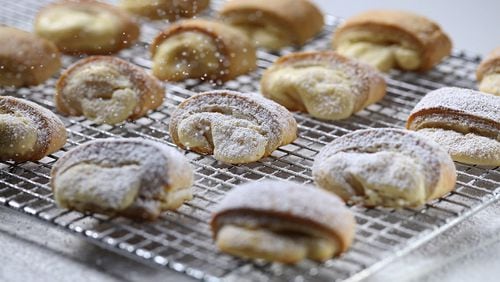At the culinary heart of Hanukkah (which begins at sundown Tuesday) are foods fried in oil to commemorate the triumph of the Maccabees, who won back their sacred temple, and the miracle of the oil that burned for eight days.
But there’s another Hanukkah story, not as well-known, that shifts the culinary narrative to a brave woman and her killer cheese. This story from the Book of Judith explains why dairy makes it onto the holiday table.
According to “The Interpreter’s Dictionary of the Bible,” the Assyrian leader Nebuchadnezzar sent one of his generals, Holofernes, to destroy the Jews of Bethulia, a town that commanded access to the road to Jerusalem. The plan was to seize the spring at the foot of the mountain, so the Jews would be deprived of their water supply.
When the cisterns in the town were empty, the people began to lose heart. It seemed better to live as slaves than to die in vain. One woman in town, a beautiful widow named Judith, had another plan.
She left Bethulia, dressed in festival garments to entice any man she might meet, and equipped with wine and food. The Assyrian guards — entranced by Judith’s looks — opened the gates of the city and escorted her up the hill to the enemy camp.
Pleased by her appearance, her beauty and her wit, Holofernes invited Judith to a banquet in his tent. When his officers left him alone with her, the general was so charmed by her that he ate the salty cheese cakes she had prepared, then quenched his thirst with her wine. More cheese cakes, much more wine. Until he fell drunkenly asleep.
And then, Judith pulled out his sword, and cut off his head.
She left the camp without arousing suspicion, her maid carrying the head in a bag. When the threatening army saw their general’s head, they panicked and fled.
Because Judith saved the Jews from a death order, many Jews honor her by eating cheese and dairy dishes: rugelach, blintzes, cheesecake, cheese latkes, even sour cream on potato latkes.
“We used to have a cake that was made out of cheese, like a fried-cheese-type thing,” says chef Laura Frankel, culinary director for Kosher Media International. Until the fried cheese tradition made it to northern and eastern Europe where they fried things in schmaltz (animal fat).
“Obviously, with kosher rules,” Frankel explained, “you can’t fry anything with cheese in schmaltz.” Mixing dairy and meat is banned in Jewish dietary laws. “So they changed the cheese out for potatoes. It was something people ate a lot of, they were filling, they were plentiful.”
This brings us to a shocking revelation. Though the original latkes were cheese latkes, the Ashkenazic Jews (who brought the latke to America) subbed potatoes.
And thus was born the latke that we all love today.
———
JUDITH’S CHEESE PASTRIES
Prep: 1 hour, 45 minutes
Chill: Overnight
Cook: 25-30 minutes
Makes: 24 to 30 pieces
Adapted from “A Treasury of Jewish Holiday Baking” by Marcy Goldman, these pastries symbolize the cheese cakes that Judith served to Holofernes. Farmer cheese is a form of cottage cheese with most of the liquid pressed out, giving it a solid, crumbly texture. For best results, refrigerate the dough 8 hours or overnight.
Cheese pastry dough:
2 1/2 cups flour
1/2 teaspoon salt
1/4 cup sugar
2 teaspoons baking powder
2 sticks (1 cup) cold unsalted butter, cut into 16 pieces
1 cup farmer cheese
2 teaspoons finely minced lemon zest
1 teaspoon fresh lemon juice
1 teaspoon vanilla extract
Filling:
1/2 pound cream cheese
1/2 pound farmer cheese
1/2 cup sugar
1 tablespoon flour
1 teaspoon finely minced lemon zest
1 egg
1/2 teaspoon vanilla extract
Pinch of salt
Topping:
4 tablespoons melted butter
Powdered sugar
1. For the dough, sift the dry ingredients together in a large bowl; cut in the butter until the mixture resembles small crumbs. Blend in the farmer cheese to make a soft dough; then the lemon zest, lemon juice and vanilla. (For a food processor, pulse the dry ingredients together until combined. Add the butter; pulse until mixture resembles small crumbs. Add remaining ingredients; pulse until dough comes together. Knead on a lightly floured board to form a smooth ball.) Wrap the dough in plastic, and refrigerate overnight.
2. For the filling, cream the cream cheese, farmer cheese and sugar together in a bowl until blended. Stir in remaining ingredients to make a thick filling. Refrigerate until ready to use.
3. Heat oven to 350 degrees. Line 2 baking sheets with parchment paper.
4. On a lightly floured surface, divide the chilled dough in half and roll each half into a 9-by-12-inch rectangle. Lightly brush each rectangle with 1 tablespoon melted butter.
5. Spread half of the cheese filling on each rectangle, leaving a 1-inch plain border all around. Fold in the 2 shorter ends on each rectangle. Beginning with the longer side, roll each piece into a log but stop halfway. Cut off the remaining half of each piece and repeat, making another log. Each portion of dough will make 2 narrow logs.
6. Brush the tops of the 4 logs with the remaining 2 tablespoons melted butter. Chill, 10 to 15 minutes.
7. Remove logs from the fridge; cut them into 2-inch pastries. Place the pastries on the baking sheets. Bake until tops are golden brown, 25 to 30 minutes. Cool slightly, then dust with powdered sugar.
Nutrition information per serving (for 30 pieces): 179 calories, 12 g fat, 7 g saturated fat, 39 mg cholesterol, 15 g carbohydrates, 7 g sugar, 4 g protein, 124 mg sodium, 0 g fiber
BLINTZ FRENCH TOAST CASSEROLE WITH BLUEBERRY SAUCE
Prep: 30 minutes
Cook: 50-60 minutes
Makes: 6 to 8 servings.
If you’re a blintz lover but need an easy-to-prepare dish, this recipe shared by cookbook author Marlene Sorosky Gray makes a great choice. Hardly traditional, it combines the flavors of crusty French toast with the creaminess of a cheese blintz. It’s great for a buffet because it stays warm for a long time. Sorosky Gray’s cookbooks have sold over a million copies and have won best book awards from both James Beard and the International Association of Culinary Professionals. Serve with her blueberry sauce, recipe below, or a store-bought sauce.
12 slices sturdy white or egg bread, sliced, crusts removed
4 large eggs
3 egg whites
1 cup milk, whole or low fat
1/4 cup maple syrup
3/4 cup orange juice
8 ounces cream cheese, regular or low-fat, at room temperature
1 cup ricotta, whole or low-fat
1 cup small curd cottage cheese, whole or low-fat
2 large eggs
1/3 cup sugar
1 tablespoon vanilla extract
1. Place bread in a single layer on a rimmed baking sheet.
2. In a large bowl, whisk eggs, egg whites, milk, syrup and orange juice until blended. Pour over bread; turn slices over to coat both sides. Set aside.
3. For the filling, place cream cheese, ricotta and cottage cheese in a food processor or a bowl of an electric mixer; blend until smooth. Mix in eggs, sugar and vanilla.
4. Butter a 9-by-13-inch glass baking dish (or coat with nonstick cooking spray). Arrange 6 slices of bread on the bottom. Spoon filling over and spread evenly. With a spatula, place remaining bread over filling. Cover and refrigerate 8 hours or overnight.
5. Heat oven to 350 degrees. Bake French toast until top is golden and casserole is puffed, 50 to 60 minutes. Serve with blueberry sauce or a store-bought sauce of your choice.
Nutrition information per serving: 528 calories, 22 g fat, 11 g saturated fat, 193 mg cholesterol, 62 g carbohydrates, 26 g sugar, 21 g protein, 711 mg sodium, 2 g fiber
BLUEBERRY SAUCE
Prep: 10 minutes
Cook: 8 to 10 minutes
Makes: 2 1/2 cups sauce
1 pint fresh or frozen blueberries
1/2 cup sugar
1 teaspoon grated lemon peel
1/2 teaspoon ground cinnamon
1/4 teaspoon ground nutmeg
1/4 cup water
In a medium saucepan, stir all ingredients together. Bring to a boil over moderate heat, and cook, stirring often, until sauce thickens slightly and sugar is dissolved, 8 to10 minutes. The sauce will continue to thicken as it cools. Sauce may be covered and refrigerated, up to 2 weeks.
Nutrition information per tablespoon: 14 calories, 0 g fat, 0 g saturated fat, 0 mg cholesterol, 4 g carbohydrates, 3 g sugar, 0 g protein, 0 mg sodium, 0 g fiber
MINI RICOTTA LATKES WITH SOUR CHERRY SAUCE
Prep: 20 minutes
Cook: 30 minutes
Makes: 34 latkes
These are light and delicious for breakfast, snacks or as a selection on a latke buffet bar at a party. Adapted from “The Essential Book of Jewish Festival Cooking: 200 Seasonal Holiday Recipes and Their Traditions” by Phyllis Glazer with Miriam Glazer. For larger latkes, use 3 tablespoons batter per piece.
Sour cherry sauce:
1 cup canned or bottled tart cherries in syrup (measure without liquid)
1 cup syrup from the can or bottle
1 tablespoon cornstarch
1 tablespoon water
1 tablespoon cherry liqueur, optional
Latkes:
1 pound whole or part-skim milk ricotta cheese
4 eggs
6 tablespoons flour
1/2 teaspoon baking powder
1 tablespoon walnut oil
2 tablespoons sugar, granulated or turbinado
1/2 teaspoon baking soda
1 teaspoon vanilla extract
Vegetable oil
1. For the sauce, mix the cherries and syrup in a small saucepan; heat over medium-low heat.
2. In a small bowl, mix the cornstarch and water until smooth. Add to the saucepan; heat, stirring, until the mixture thickens.
3. Stir in the cherry liqueur, if using, cover, and keep warm while preparing the latkes. Sauce may also be prepared in advance and reheated.
4. For the mini latkes, put all of the ingredients (except the vegetable oil) in a blender; process until smooth.
5. Heat a small amount of oil in a skillet over medium-high heat; drop in batter by heaping tablespoons. Flatten them with the back of a spoon to make circles. Cook until lightly brown on the bottoms; flip and cook the other sides. Repeat with remaining batter. Serve immediately, with the sauce.
Nutrition information per latke: 57 calories, 3 g fat, 2 g saturated fat, 29 mg cholesterol, 4 g carbohydrates, 1 g sugar, 2 g protein, 46 mg sodium, 0 g fiber
About the Author






